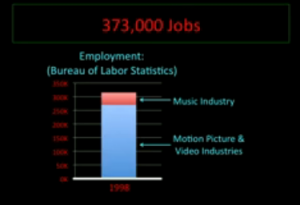
This is a short TED Talk by Rob Reid (The $8 billion iPad) that tries to infuse a little “reasonability test” into our blind belief in the numbers provided by those with self-interest … in this case, the music/entertainment industry.
There are several examples that you could turn into signed number addition or subtraction problems. In my favorite example (about 2:57 in the video), Reid uses what he calls “Copyright Math” to “prove” that by their own calculations, the job losses in the movie industry that came with the Internet must have resulted in a negative number of people employed.
Here’s the word problem I’d write:
In 1998, prior to the rapid adoption of the Internet, the U.S. Motion Picture and Video Industry employed 270,000 people (according to the U.S. Bureau of Labor Statistics). Today, the movie industry claims that 373,000 jobs have been lost due to the Internet.
[Prealgebra] There are many ways to interpret this claim. If all these jobs were all lost in 1999, how many people would have been left in the motion picture industry in 1999? If the 373,000 jobs were spread out over the last 14 years, then on average, how many jobs were lost each year? Using this new “annual job-loss” figure and no industry growth, how many jobs would have been left in 1999? Can you think of other ways the quoted figures could be interpreted? Use the Internet to see if you can find out how many people are employed in the motion picture industry today. [Prealgebra]

[Intermediate Algebra] If the job market for the motion picture and video industry grew by 2% every year (without the Internet “loss” figures), how many people would be employed in 2012 in the combined movie/music industries? How many jobs would have been created between 1998 and 2012 at the 2% growth rate? If the job market grew by 5% every year (without the Internet “loss” figures), how many people would be employed in 2012 in the combined movie/music industries? How many jobs would be created between 1998 and 2012 at the 5% growth rate?



